Not all offers are created equal.
There are tons of different offers you can sell your audience, and even more ways you can make money with your newsletter.
This deep dive will not be covering all of those things.
What we're going to be doing is:
- Looking at some of the most prominent digital products sold in some of the most successful Creator Newsletters.
- Ranking them based on the amount you can charge, and the amount of work and freedom that come with them.
These will be the main points we discuss, and the overall scale and rank that I give each type of product, but we'll also be analyzing a few other things:
- Leverage Needed: The authority and size of your following needed to be able to make certain offers work.
- Initial Work Needed: The amount of time needed in order to launch the offer.
And if it wasn't obvious based on the first section of what we're covering: a large portion of what we're going to be analyzing is the continuous workload to be able to sell the offer.
Here are some of the offers we're going to be looking at:
- Cohorts
- Courses
- Coaching
- Community
- Other Digital Products
We have already discussed monetization methodology in past deep dives, so while I recommend reading this one all the way through, you can also go back through some of these deep dives to get additional information:
- The Top 5 Spots To Sell In Your Newsletter
- The Top Three Ways To Monetize Your Newsletter
- The Ultimate Guide To Newsletter Business Models
- How To Add A Sponsorship Section In Your Newsletter
For now, let's discuss some offers:
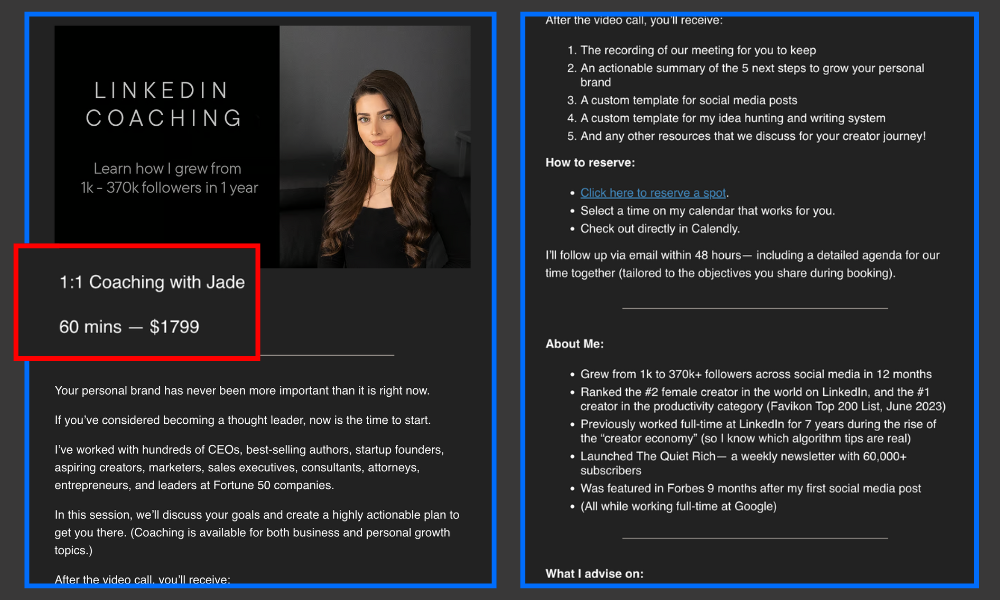
📬 Coaching and Consulting
There are SO many ways to structure coaching offers that I can't even begin to break them all down in one small section, but I want to analyze some smaller examples.
But first, here's how I'm ranking coaching on our scale:
- Freedom: Very Low
- Price Point: High
- Initial Work: Low
- Following Needed: Low
- Authority Needed: Very High
Note: We'll discuss more about each of these points below and I'll wrap it up at the end of our examples.
🔍 Jade Bonacolta Coaching Offer
Jade Bonacolta has a Hybrid Newsletter [business model] because her niche is extremely broad, and she doesn't sell anything actually pertaining to her niche topics.
For example: She writes about productivity, life hacks and minimalism, but she sells products built around how to grow your audience.
It's important to be aware of this as we break down her paid offer a bit more.
As you can see above, Jade's core offer has been a 1:1 Coaching Offer for $1799.
You also receive:
- The recording of the call
- An actionable summary with the next 5 steps to take.
- A custom template for social posts.
- A custom template for idea hunting.
- A custom template for writing system.
- And any bonuses discussed on the call.
Each of these things take time away from Jade to be able to craft custom for each person she coaches.
It also takes her time to prepare for the coaching call, and to respond and prepare the call information within 48 hours of her audience booking.
Each of these ongoing tasks (among others that come with coaching offers) result in me ranking coaching as a low level of freedom.
You also need quite a bit of authority to be able to charge $1799, especially if you're only offering one call (you can offer 1-3+ months of weekly calls, and other offers, as we'll discuss more).
Note: That authority usually doesn't necessarily mean you need a large following (Jade is selling "growth" so she needed a large following to prove the authority needed for a higher price point).
That said, the initial workload on a coaching offer is essentially non-existent.
All you need is to have an offer and solution to provide, make a cart, and start selling some calls to provide a ton of problem solving value!
🔍 Scaling Out Of Coaching Offers
As I mentioned, there are a lot of ways you can structure coaching offers.
Jade Bonacolta's mentor and now partner, Ben Meer, also offers different pricing packages for his coaching, including a 12 week program that offers weekly calls, ad-hoc support and more.
Coaching is a great starting point.
It allows you to test offers and positioning and make sure what you're offering is needed; but it's not usually a good long term, scalable plan.
You see creators like Amy Porterfield, Justin Welsh, Kieran Drew and many others start with coaching and consulting and then pivot out of it as soon as they have enough leverage to make the other offers we'll discuss work for them.
I have been asked about coaching and consulting a TON now for Creator Newsletters; but unfortunately the time investment just generally isn't worth it once you're making a certain amount of money.
Freedom and time are just more valuable.
BUT, there are offers that allow you to do both...
🔍 Your Action Plan:
Just starting out?
Consider starting with a high touch offer like coaching, consulting, or even some kind of "Done For You" work.
But, beware that coaching and done for you work can eat up a lot of your time and end up resulting in you having to pull back on the work that is going to result in building enough leverage to scale your ACTUAL freedom business.
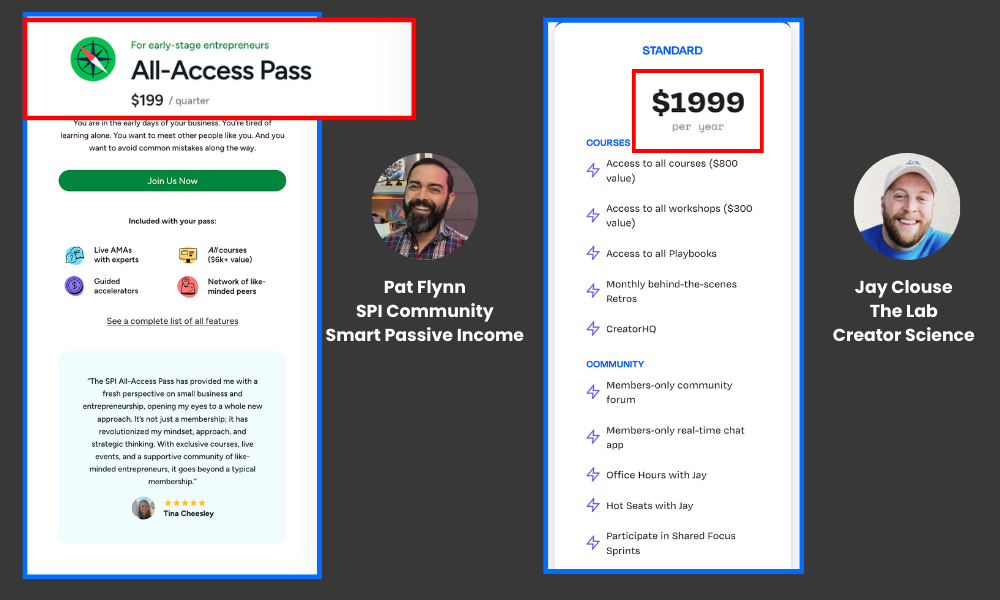
📬 Paid Communities
Communities are extremely popular right now; and a lot of people are excited by the idea of having recurring payments coming in on a monthly basis.
BUT, there are a lot of things to consider before starting one...
Here are the Community Rankings:
- Freedom: Low-Medium
- Price Point: Medium-High
- Initial Work: Medium-High
- Following Needed: High
- Authority Needed: Medium-High
Note: We'll discuss more about each of these points below and I'll wrap it up at the end of our examples.
🔍 Pat Flynn and Jay Clouse Community Offer
It feels like everyone is starting a community.
But, like newsletters, that just makes it more important than ever to provide a ton of value to your audience.
I chose to analyze Pat Flynn and Jay Clouse's community offers because I have been in a community with both of them, and have heard Jay discuss the work that goes into his in a ton of depth on his own podcast [and others].
I was part of the SPI Community years back when Jay was actually a big part of it, before he had The Lab.
Pat has TONS of help inside the community, and hosting one that has a lot of members is a LOT of work.
The fact that you're able to bring in recurring revenue puts this one on a medium to high price point scale (medium because it takes a lot of work to eliminate churn).
BUT, the freedom is only a slight step up above coaching and consulting style offers when you factor in the need for group coaching calls, engagement, consistent value adds (more offers coming in), and more.
On top of that, it generally takes a lot of leverage to get started.
You need to have a large enough following to fill up a community and make sure there are people inside engaging and actually making it feel like a community.
AND, as you can see from the two examples I chose above: it often also takes having an array of offers already inside waiting for your audience to get started with.
In the case of Pat and Jay: you get a ton of courses and digital products as soon as you enter, on top of other exclusive access.
🔍 Scaling UP To Community Offers
In my opinion, communities are something you scale UP TO, not out of, like coaching.
If you have a team member or two that can manage the community and you are able to hop in at times for group coaching calls and engagement; it can be a great way to scale in a "One To Many" instead of "One To One" style.
- One To One: Coaching Calls with One Person
- One To Many: Group Coaching Calls with Many People
Tack on the fact that if you scale UP TO a community offer over time you can also have courses and digital products you have previously launched in their waiting for your audience, and now you're set to overdeliver and reduce potential churn before you even get started.
🔍 Your Action Plan:
Before planning to launch a community, ask yourself if you have enough leverage.
Do you have enough of a following (or support) to make a "community" engaged in the first place? Do you have an offer suite for them to take advantage of when they enter? Do you have a way to keep them consistently engaged and provide ongoing value?
Communities can be extremely lucrative, but also extremely hard to make successful.
NOTE: This is one of the reasons I am not a big fan of paid newsletters as a monetization strategy. Some of the most successful outliers making money with paid newsletters essentially run a community with ongoing support, exclusive calls and access, and can be charging much more than what they can with paid newsletter positioning.
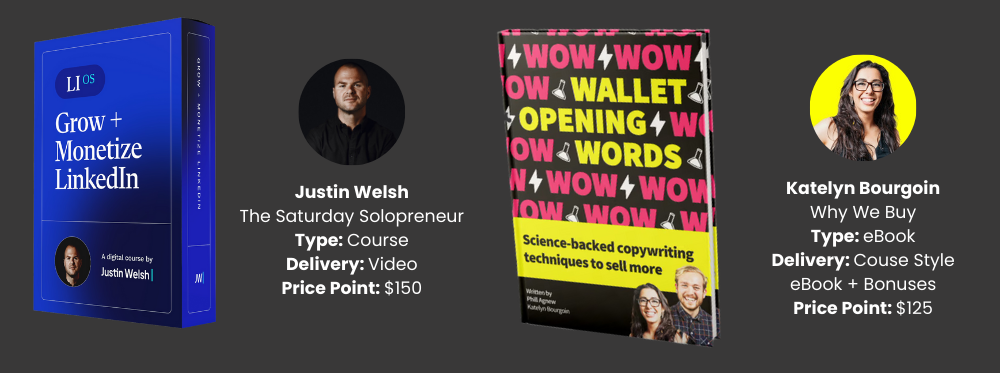
📬 Courses and Digital Products
There's no denying that courses and digital products are the ultimate freedom hack for your online business.
I don't think anyone is questioning that...BUT, how long does it take to make it happen...?
Here are the Course Rankings:
- Freedom: Very High
- Price Point: Low-Medium
- Initial Work: High
- Following Needed: Very High
- Authority Needed: Medium
Note: We'll discuss more about each of these points below and I'll wrap it up at the end of our examples.
🔍 Justin Welsh and Katelyn Bourgoin Courses
Justin Welsh made over $2M on courses in 2023.
When he was originally starting and scaling his online business he started with consulting and coaching; helping B2B SaaS Founders to scale.
From there he ran a community, and then eventually launched his LinkedIn OS (after a couple other launches that were closed) that became his main offer, only adding his Content OS course to his offer suite and keeping those as his main two offers for a few years.
Note: He has recently released a new course, The Creator MBA, that he just launched in 2024 (making $1.6M on a single launch...!).
If you don't know him well enough, he is the man behind "Solopreneurship"; putting freedom first.
And how does he do that?
Social -> Newsletter -> Course Sales
That's it.
I also added Katelyn Bourgoin in our image as an example because I wanted to note that your digital product freedom doesn't HAVE to come from courses.
There are other things to sell to your audience that can do extremely well.
For example: Katelyn released her most recent digital product "Wallet Opening Words" as an in depth eBook, but bundled it with other bonuses to make it super actionable AND value packed.
Another great example is Jay Clouse's most recent launch of his product "Creator HQ", which is is all-in-one operating system for his business and content (hosted in Notion).
Freedom is extremely high on courses because you make them once, and sell forever.
BUT, because you're only selling them at a price point of $97-297 (usually), you need a lot of volume to create that freedom.
Launches do extremely well, even with a small following (I launched my course The 6-Figure Creator Newsletter Blueprint to just 500 people and made $5000+ on just the course, and tripled that if we include upsells and backend offers) but you're generally only launching once every 3 months or so.
On top of that, you have to put in a good amount of initial work to actually create a course, which in turn leads to you needing to put in a lot of work to validate whether or not your audience wants it.
🔍 Diversifying With Digital Products
There are SO many digital products you can have in your offer suite, and I'm just discussing a small handful.
I don't like to clog up my offers and make it harder for my audience to make a decision, so keeping it nice and simple is optimal.
I won't mock up a value ladder for you (we'll be doing that at the end of this deep dive), but I do want to mention some other lower ticket digital products you can consider:
- eBooks
- Booklets
- Templates
- Mini-Courses
- Cheat Sheets
And obviously a lot more.
These can be a great spot to start monetizing without having to spend so much time building a full product like a video course or something that costs $97-297+.
This can also help you pre-validate and make sure your offers are aligning with the audience you're attracting.
🔍 Your Action Plan:
There is a very high chance you'll be selling a course or some kind of digital product that ranges between $97-297 in the future [if your goal is to run a successful Creator Newsletter].
If you already feel like you've validated your potential offers, then there could be good reason to launch it and then iterate on it and relaunch over time.
If you are still validating, then start really listening to your audience and learning from them more than you already are. Ask more questions. Get their feedback on what type of courses/products you are considering.
Do NOT underestimate the power of listening to your audience.
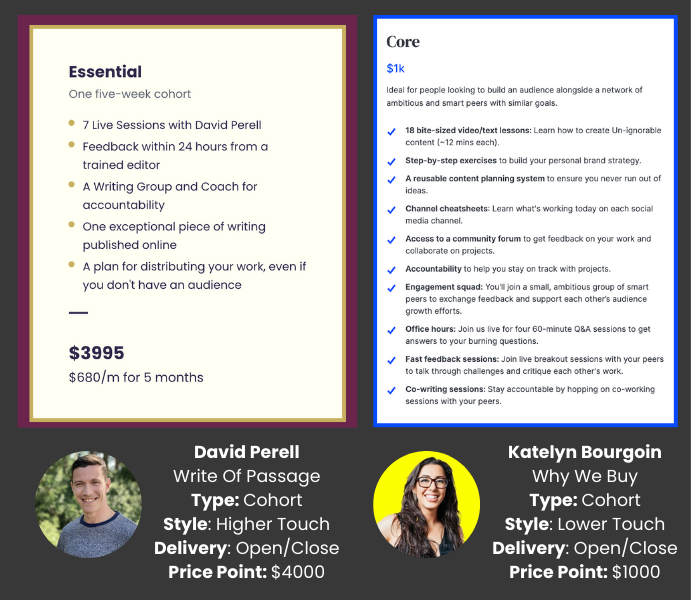
📬 Cohorts and Hybrid Offers
Cohorts are the happy place that combine courses, coaching, and community all into one offer while allowing you to "open" and "close"; hitting on FOMO and scarcity each time.
And, to top it off, you can charge higher price points while still keeping it "One To Many".
For example, instead of charging $5000 for a 3 month coaching program to one person, you could charge $1000 for a 3 month cohort for 100+ people.
Just to be clear, that's $100,000 VS. $5000.
Here are the Cohort Rankings:
- Freedom: Medium
- Price Point: Medium-High
- Initial Work: High
- Following Needed: High
- Authority Needed: Medium-High
Note: We'll discuss more about each of these points below and I'll wrap it up at the end of our examples.
🔍 David Perell and Katelyn Bourgoin Courses
There are a ton of successful cohorts we can rattle off, ranging from David Perell and Katelyn Bourgoin all the way to Dickie Bush/Nicolas Cole's Ship 30 (which has now been turned into a course) and Justin Moore's Brand Deal Wizard.
But what do they all have in common?
Leverage of a large following, and high authority.
The one great part of cohorts to consider is that you can actually adjust the price point based on the level of "touch" you want to provide.
For example: If you plan on being more involved in weekly live calls and coaching within the community, you can easily charge $3000 for a 3 month cohort [assuming you have the authority].
Alternatively, if you want to provide pre-recorded lessons and only have certain levels of group coaching at specific times, you can drop the price to $1000 and still sell to a high volume.
That said, even though we're combining the GOOD parts of courses, coaching and cohorts...
We need to reiterate that we're combining the negatives as well.
If you want to have enough of a "community" aspect to keep it engaged, you need to have a large enough following to make sure you can fill the cohort.
You also need to put the time in to have enough course material ready to take all your students through similar to if you were to be releasing a course.
(Note: There are some cohorts that stay super small and higher ticket with 10 people in them instead of going larger 50-100+, but you lose some of the allure of being able to sell a higher price, one to many. It may be more optimal to wait until you have more leverage.)
I have seen cohorts open and make 100-500K, run for 3 months, close and cruise, and then re-open to do it again in another few months.
This seems to be an ideal plan once you have the leverage.
BUT, until then you need to be validating.
🔍 Your Action Plan:
I'm not a huge fan of smaller cohorts.
I would personally rather leverage courses and other digital products while spending the extra time I have on growing my audience to get to a much bigger cohort launch.
That said, you have the option to consider a smaller cohort if you want to test it.
Either way, though, you'll want to validate your offer ahead of time the same way you would have to with a course or community being that you'll need to put the time in to have material ready.
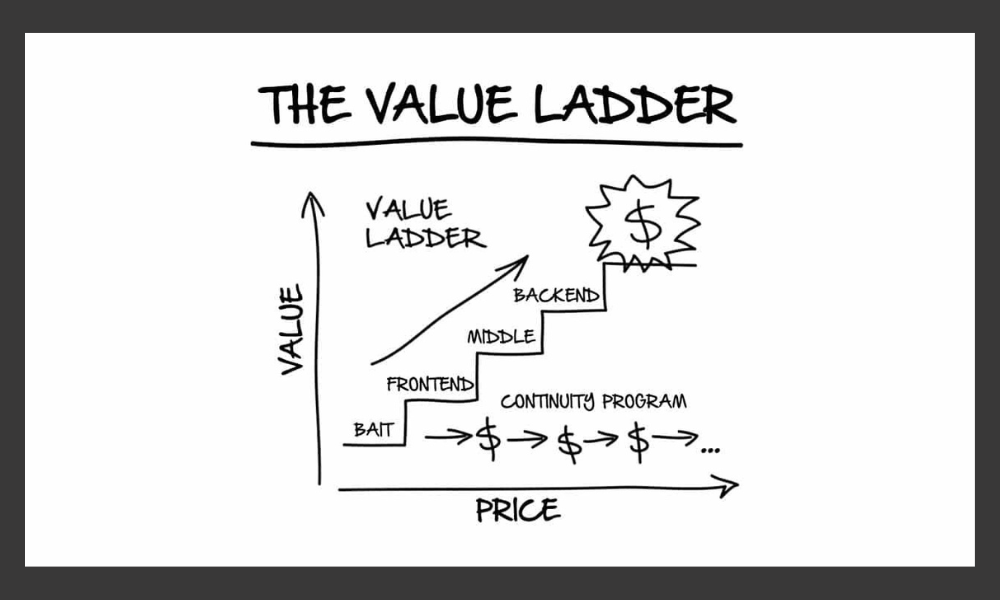
📬 Building Out Your Value Ladder
Ultimately your goal is to build out a full value ladder that contains multiple offers.
If you follow Russell Brunson you are already familiar with the image above, and know the definition of a value ladder is:
"A marketing strategy that is designed to take customers on a journey from a low-priced entry-level offer to a high-priced premium product."
Not every creator will have a full value ladder, but having a plan for one and then learning from your audience and making pivots as you grow is an essential part of being able to build out a Creator Newsletter.
To give you a better idea, let's go through a couple value ladders.
To start with an example without actual offers, here's how it should look.
- Lead Magnet (Freebie)
- Frontend Offer (Low Ticket)
- Middle Offer (Mid Ticket)
- Backend Offer (High Ticket)
From there we can see how it could stack up when we look at some creators value ladders.
For example, here's Dickie Bush and Nicolas Cole:
- Lead Magnet: Email Based Course(s)
- Frontend Offer: Low Ticket Books
- Middle Offer: Ship 30 and Workshops
- Backend Offer: Premium Ghostwriting Academy
Again, you don't need the full ladder.
Here's an example of a smaller ladder that I could have for myself:
- Lead Magnet: Ultimate Guide To Lead Magnets
- Frontend Offer: Creator Newsletter Secrets eBook
- Middle Offer: The 6-Figure Creator Newsletter Blueprint
Which could eventually level up to a cohort, async coaching, or even evergreen group coaching like Premium Ghostwriting Academy.
This is why you always lead with value even with your free content.
- Lead with value.
- Overdeliver.
- Then repeat with your lower ticket product.
- And again with your mid ticket.
This is how you scale and win the game of Creator Newsletters.



